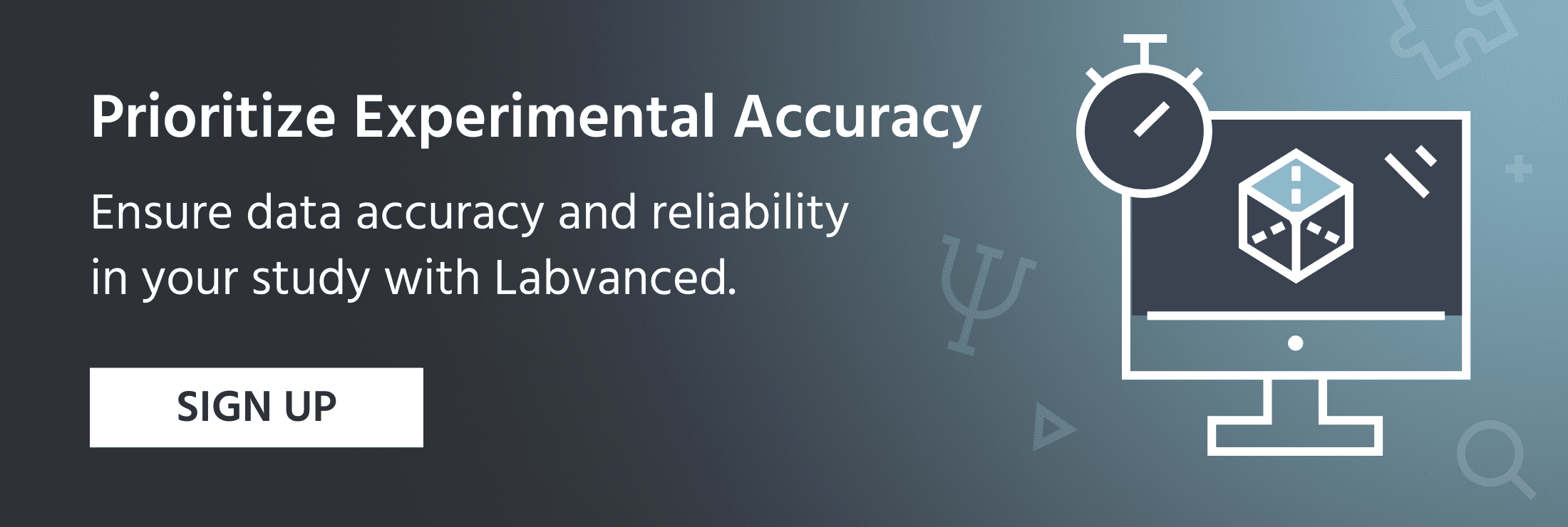
Experimental Control
The rise of remote research makes a lot of psychologists wonder about the soundness and extent of experimental control that having a study online has to offer. In a lab setting, researchers try to control as many potential confounds as possible to avoid accidentally introducing additional variability that could impact the observed results.
Background
To ensure experimental control, a specific protocol is put in place before an experiment begins. The protocol is designed in order to minimize unwanted effects as much as possible. This might include defining how far a participant is seated away from a screen, demographic requirements, or device specifications.
Researchers conducting in-person experiments have control over many factors as they are able to take matters in their own hands and this is one of the main reasons why experiments are often performed in laboratories. However, remote studies require a strong system in place in order to assure experimental control because the researcher is not immediately present to directly oversee the participant.
Our process: The pipeline bringing experimental control online
To ensure experimental control for online studies, we employ a number of advanced techniques and methods to ensure that high-quality data is captured from participants completing the experiment remotely. These methods are classified into three broad categories:
- Controlling the device and hardware: Taking into account factors relating to the hardware, such as device specifications or screen size.
- Controlling the participant and environment: Controlling the who, the characteristics of the participants you want completing your study, as well as their remote environment, such as lighting.
- Controlling engagement: Monitoring engagement such as attention during the experiment, bot checks, and more.
- Ensuring precise stimuli presentation: Quantifying exactly when stimuli are presented on a millisecond level.
Experimental control is accomplished by measuring and accounting for these four broad categories.
1. Device & Hardware: Experimental Control
In a lab setting, you already know your computer or tablet specifications, what devices you are using, and their CPU and GPU speed. However, when performing your study online, these will vary across the participants.
With Labvanced you can specify and restrict: what kind of devices and browsers you want to allow in your study, the desired monitor refresh rate, as well as minimum and maximum screen size, as well as screen orientation in the case of studies conducted on mobile devices.
Furthermore, any issues with delays and CPU speed are reported due to the strict methods we have in place in order to ensure precision timing.

2. Participant & Environment: Experimental Control
Additional variables that can influence results pertain to the participant’s characteristics and demographics, as well as their immediate environment.
For a study to be as planned, the participant’s personal demographics are very important, such as their: age, gender, language proficiency, education, job, health status and more. In Labvanced, these parameters can be selected so that the participant is required to provide these upfront before being admitted to proceed further with the experiment. Labvanced also goes a step further by controlling for the participants’ environment. To measure distance from the screen, we calculate the angle from the participant’s blindspot in the eye.

3. Engagement: Experimental Control
To ensure appropriate engagement, there are several strategies that can be put in place.
When an experiment begins, it is presented in full-size, ensuring that it is the only thing that the participant sees. If they remove the experiment from fullscreen, the experiment is automatically paused.
In the case of eye tracking, Labvanced employs a virtual chin rest, so any time that a participant moves too much out of the frame, the experiment stops and the participant is instructed to return to their initial position.
Importantly, bot checks can be added to any study to ensure human participation during an experiment.

4. Ensuring Precise Display of Stimuli
The topic of precise presentation of stimuli is intricately related with experimental control. Read more about how Labvanced ensures precise stimuli display here.

Also, check out this peer-reviewed paper in the journal of Behavior Research Methods from a neutral third-party discussing the high reliability of Labvanced's approach to ensure precise stimuli presentation.